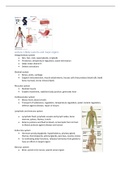Lecture 1 Body systems and major organs
Integumentary system
• Skin, hair, nails, sweat glands, oil glands
• Protection, temperature regulation, waste elimination
• Helps make vitamin D
• Detects sensations
Skeletal system
• Bones, joints, cartilage
• Support and protection, muscle attachments, houses cells that produce blood cells (redd
bone marrow), stores mineral lipids
Muscular system
• Skeletal muscle
• Enables movement, stabilises body position, generates heat
Cardiovascular system
• Blood, heart, blood vessels
• Transport of substances, regulation, temperature regulation, water content regulation,
defence against disease, repair of tissues
Lymphatic and immune system
• Lymphatic fluid, lymphatic vessels and lymph nodes, bone
marrow, spleen, thymus, tonsils
• Returns proteins and fluid to blood, carries lipids from GI tract
to blood, protects against disease and cancer
Endocrine system
• Hormone producing glands: hypothalamus, pituitary gland,
thymus, thyroid glands, adrenal glands, pancreas, ovaries, testes
• Co-ordinating body functions, releases hormones from glands to
have an effect on target organs
Nervous system
• Brain, spinal cord, nerves, special sense organs
, • Generate nerve impulses to regulate body activities, detects stimuli and responds to them,
initiates muscles contraction or glands
Respiratory system
• Lungs and air passages, pharynx, larynx, trachea, bronchioles, alveoli
• Gaseous exchange
• Regulates acid-base balance of body fluids
• Enables sound production when air passes through vocal cords
Digestive system
• Mouth, pharynx, oesophagus, stomach, small and large intestines, salivary glands, gall
bladder, liver, pancreas
• Physical and chemical breakdown of food, absorbs nutrients, eliminates soldi waste
Urinary system
• Kidneys, ureters, bladder, urethra
• Produce, store, and eliminate urine, eliminated metabolic wastes, regulates volume and
chemical composition of blood, helps to maintain the acid-base balance of the body fluids,
regulates production of ed blood cells.
Reproductive system
• Ovaries, uterus, Fallopian tubes, vagina
• Testes epididymus, vas deferents, penis
• Gamete production, hormone release, regulate reproduction and associated body changes
during puberty
Lecture 2 & 3 tissue types and structures
Basic tissue types
• Epithelial tissue
• Muscle tissue
• Nervous tissue
• Connective tissue
Types of cell junctions
• Tight
• Adherens
• Desmosome
• Hemidesmosome
• Gap
, Nervous tissue
1. Neurons – generate and conduct nerve impulses
• Cell body – nucleus and other organelles
• Dendrites – receive signals
• Axon – conduction over long distance
2. Neuroglia – non-conducting; insulate, support, and protect neurons
Muscle tissue
1. Skeletal
• Long cylindrical cells containing many peripheral nuclei




